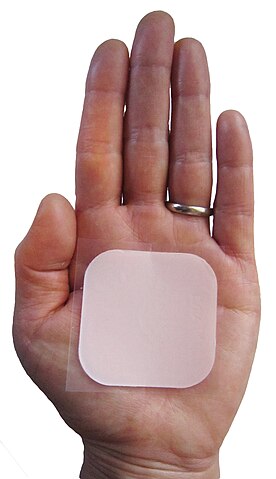California, Oregon Pharmacists Can Prescribe Birth Control Pills: Uncoupling Exams From Prescriptions
By Sarah Breitenbach, Stateline
Since January, Charley McGrady has been doling out hormonal contraceptive pills and patches to women who come to her Eugene, Oregon, pharmacy without a doctor’s prescription for birth control.
A new state law allows McGrady to consult women about pregnancy prevention and write prescriptions for contraceptives that previously required a doctor’s signature.
Oregon’s move to pharmacist-prescribed birth control is an attempt to increase access to the drugs and reduce unintended pregnancies, which make up more than half of all pregnancies in the United States. It also is part of a movement toward team-based medical care, in which doctors and other medical professionals together oversee patients’ care.
An Ortho Evra birth control patch with the plastic backing still on; Wikimedia Commons
California pharmacists will begin writing their own prescriptions for birth control next month, and lawmakers in Hawaii, Missouri, South Carolina, Tennessee and Washington are considering legislation that would give pharmacists the power to prescribe contraceptives.
Pharmacists in several states already can prescribe certain drugs under the supervision of a physician, but laws like those in Oregon and California give them autonomy to prescribe contraceptives on their own after completing a training course.
The California law is more expansive than Oregon’s. It allows pharmacists to prescribe a vaginal ring and hormonal birth control shots in addition to pills and patches that release hormones through the skin. In California, where about half of pregnancies are unplanned, the law also lets them furnish contraceptives to women under 18. (In Oregon, only pharmacists working directly with a physician can prescribe to women who are under 18.)
McGrady said she has consulted with 13 patients about birth control at her Safeway pharmacy since the law took effect at the start of the year. She filled prescriptions for 11 of them and referred the remaining two to doctors for further evaluation.
“They seem to be between insurance, maybe between doctors [or] they just moved here,” she said of the women who have come to see her. “But they have the resources to purchase their birth control.”
To get a prescription for hormonal birth control, which most commonly uses a combination of estrogen and progestin to prevent ovulation, a woman typically must visit a doctor or clinic.
Sometimes those visits also include pelvic exams or pap smears that have no medical bearing on whether a woman can get a prescription for birth control, said Paige Clark, a pharmacist with Oregon State University (OSU) College of Pharmacy. Uncoupling the exams from prescriptions improves access to the contraceptives, she said.
Visiting a doctor for a prescription can be difficult for many women because they lack health insurance to cover the visit, cannot take time off work for an appointment, or have trouble finding a doctor with an opening to see them, Clark said.
Getting birth control from pharmacies could be easier because they can accommodate walk-in patients and are usually centrally located in communities — 93 percent of Americans live within five miles of a pharmacy.
“This is really about not putting any barriers between the patient and their direct access to birth control,” Clark said.
So far 250 of Oregon’s roughly 3,800 pharmacists have completed the OSU-run training and can prescribe birth control, though more are signing up every day and Clark expects to have more than 1,000 pharmacists certified by June.
It is too early to know if the program is reducing unplanned pregnancy. But Clark reports that, anecdotally, more than 90 percent of patients seen by the newly trained pharmacists are receiving prescriptions for birth control. Others are referred to physicians.
Pages: 1 · 2
More Articles
- Jo Freeman Reviews: Lady Bird Johnson: Hiding in Plain Sight
- Jo Freeman Reviews Mazie's Hirono's Heart of Fire: An Immigrant Daughter's Story
- *KFF: Gaps in Cost Sharing Protections for COVID-19 Testing and Treatment Could Spark Public Concerns About COVID-19 Vaccine Costs
- How are States Prioritizing Who Will Get the COVID-19 Vaccine First? CDC’s Advisory Committee on Immunization Practices (ACIP) Released an Interim Recommendation For the Highest Priority Group
- 4.7 Million Uninsured People Nationally Could Get a No-Premium Bronze Plan in the ACA Marketplace, Though Deductibles Would be High
- The Pros and Cons of ‘Free College’ and ‘College Promise’ Programs: What the Research Says
- States Flubbed the Rollout of Their Health Insurance Exchanges. Now They’re Ready to Try Again
- STATELINE: How Disaster Warnings Can Get Your Attention
- Barriers to Health Care Experienced by Women in the United States; Harvard Health on Screening Women Over 75; USPSTF Guidelines for Women Over 50
- Too High To Drive: States Grapple With Setting Limits On Weed Use Behind Wheel; Rhode Island, Pennsylvania and Indiana are Among States That Forbid Driving at Any THC Level







